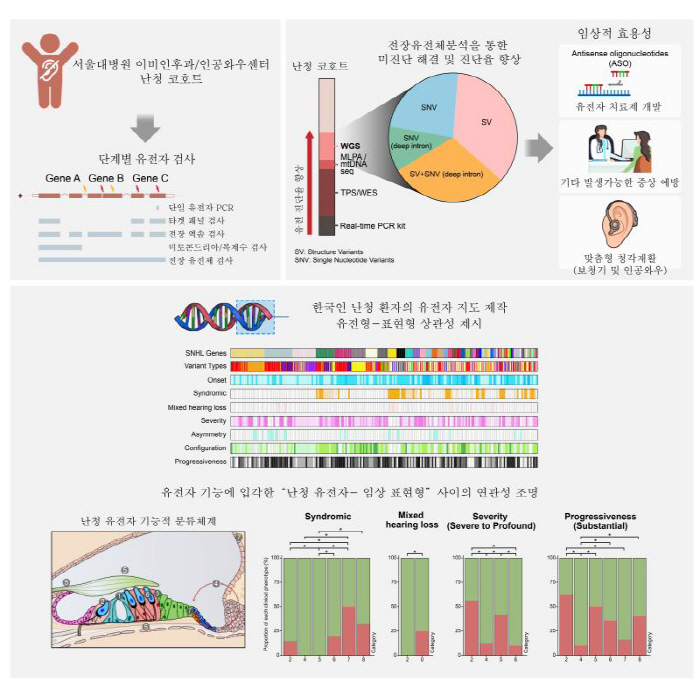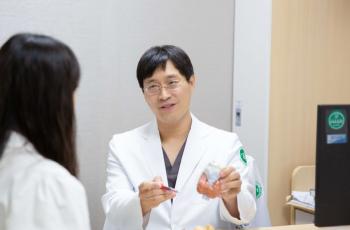Seoul National University Hospital discovers deaf mutations and builds a genetic map of hearing loss in Koreans
Jul 06, 2025
|
The research team made an important new discovery on the genetic cause of hearing loss, recording a diagnosis rate of about 20% better than conventional precise analysis methods using WGS. The findings were published in the latest issue of Cell's sister journal, the international journal of medical research and experimentation.
Hearing loss is divided into total negative hearing loss (occurring due to external and middle ear problems) and sensory nerve hearing loss (occurring due to neurotransmission problems between the auditory nerve and the brain), and sensory nerve hearing loss can be caused by various causes such as genetic causes, innate infections, trauma, drug toxicity, autoimmune diseases, etc.
Until now, the genetic causes of hearing loss have been very diverse and complex, making it difficult to accurately identify the genetic cause in many cases, and existing target panel tests and full-length exome tests alone did not find the genetic cause in about 50% of patients. Accordingly, this study attempted to identify a wider range of genetic mutations through a step-by-step approach, including WGS analysis.
The research team consisting of Lee Sang-yeon, a professor of pediatric otolaryngology at Seoul National University Hospital, Chae Jong-hee and Lee Seung-bok, a professor of clinical genomics medicine, Dr. Ko Joon-young of Inocras, and Dr. Park Sung-yeol of Stanford University's genome research lab announced the results of a study on the genetic cause of sensory nerve hearing loss on 394 households (752 people) of ear, nose and throat and artificial woo center hearing loss at Seoul National University Hospital on the 3rd.
The research team identified major genes such as GJB2 through a single gene PCR test through a step-by-step genetic testing approach, analyzed a wider range of genes with target panel tests (TPS) and full-length exome tests (WES), and identified structural mutations and deep intron mutations (non-coding region mutations) that were not found with conventional tests (TPS, WES) through WGS in the final stage.
As a result of the study, this step-by-step approach, including WGS analysis, identified the genetic cause in 219 of 394 households with sensory nerve hearing loss. In particular, by discovering an additional 19.2% (44 households) of mutations that were not identified by the existing detailed examination method (TPS, WES), the diagnosis rate of hereditary hearing loss could be improved by about 20%. This contributed to increasing the overall diagnosis rate by discovering new mutations missed by conventional tests by WGS analysis.
In addition, in this study, non-coding region variation and structural variation, such as deep intron variation, were identified for the first time. Deep intron variation is a variation that occurs in the non-coding region that exists beyond the boundary of exons and introns, which plays an important role in protein production within genes, and was not identified by conventional testing methods. This finding has provided new insights into the genetic causes of hearing loss.
In particular, three new deep intron mutations found in the USH2A gene, a representative gene for Usher's syndrome, caused splicing errors, affecting protein production and, above all, could be linked to the development of RNA gene therapeutics targeting deep intron mutations.
The study presented a genetic map of Koreans with hearing loss and showed that WGS analysis can be an important tool for accurately identifying the genetic cause of hearing loss. The research team provided a specific map of genetic mutations related to hearing loss in Koreans and contributed to understanding the various clinical characteristics of hearing loss through genotype-phenotype analysis. This study is expected to make an important contribution to the development of gene-based customized treatments in the future.
Professor Lee Sang-yeon (Children's Otolaryngology) "This study has newly identified the cause of many undiagnosed hearing loss patients and discovered a group of patients with gene therapy."In the future, we will make more efforts to solve the causes of undiagnosed hearing loss by actively utilizing WGS analysis for precise treatment linkage of childhood hearing loss." Meanwhile, this study was conducted with Lee Kun-hee's research project on childhood cancer and rare diseases and support for excellent new research by the Korea Research Foundation.
|
This article was translated by Naver AI translator.















